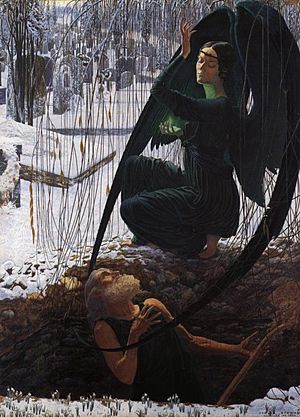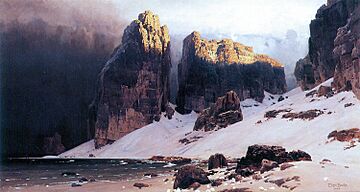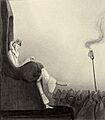Symbolism (arts) facts for kids

Death and the Grave Digger (La Mort et le Fossoyeur) (c. 1895) by Carlos Schwabe is a visual compendium of symbolist motifs.
|
|
| Years active | from the 1860s |
|---|---|
| Country | France, Belgium, Russia, others |
| Major figures | Charles Baudelaire; Stéphane Mallarmé; Paul Verlaine |
| Influences | Romanticism, Parnassianism, Decadent movement |
Symbolism was an art style that started in the late 1800s. It began in France and Belgium. This movement aimed to show deep, hidden truths using symbols and metaphors. It was a way of reacting against styles that focused only on showing reality as it was.
In writing, Symbolism really took off with Charles Baudelaire's book Les Fleurs du mal in 1857. The works of Edgar Allan Poe were a big influence. Poets like Stéphane Mallarmé and Paul Verlaine helped develop this style. In the 1880s, the term "symbolist" was first used by critic Jean Moréas. He wanted to tell Symbolists apart from the similar Decadent artists.
Contents
What Does "Symbolism" Mean?
The word symbolism comes from "symbol." This word comes from the Latin symbolum, meaning a sign of faith. It also comes from the Greek symbolon. In ancient Greece, a symbolon was a broken piece of pottery. Two people would each keep half. When they put the pieces back together, it showed they recognized each other.
How Symbolism Started
Symbolism was mostly a reaction against naturalism and realism. These older styles tried to show life exactly as it was. They focused on everyday things. Symbolism, however, wanted to show spirituality, imagination, and dreams. Some writers, like Joris-Karl Huysmans, even changed from naturalism to symbolism. This happened as they became more interested in religion.
Symbolist poets also had a link to Parnassianism. This was a French writing style just before Symbolism. Symbolists liked the Parnassian idea of "art for art's sake." This means art should be beautiful for its own sake. But Symbolists also wanted more freedom in their writing. They liked playing with words and the musical sound of poems.
One person who really helped promote Symbolism in Paris was Joséphin Péladan. He was an art critic and also interested in magic. He created the Salon de la Rose + Croix. This was a place where artists could show their work. These artists focused on spiritual and mystical ideas. Many Symbolist artists were part of this Salon.
The Symbolist Movement
The Symbolist Manifesto

Jean Moréas wrote the Symbolist Manifesto in 1886. This was a very important paper. It named Charles Baudelaire, Stéphane Mallarmé, and Paul Verlaine as the top poets of the movement. Moréas said that Symbolism was against "plain meanings" and "matter-of-fact description." Instead, its goal was to "clothe the Ideal in a perceptible form." This means showing big ideas through things you can see or feel.
Mallarmé explained it simply: "to depict not the thing but the effect it produces." He also said that poetry should always have a bit of a mystery. It should make you guess and discover meaning slowly.
Symbolists believed that beauty itself held a higher meaning. This idea was similar to ancient Greek philosopher Plato's ideas about "the Good, the True, and the Beautiful."
Writing Techniques

Symbolist poets wanted to make poetry more free. They liked using free verse, which doesn't follow strict rules. Their poems tried to *suggest* feelings rather than just *describe* things. They used symbolic images to show the poet's inner feelings.
They also loved synesthesia. This is when you mix up different senses. For example, a poet might describe a sound as a color. In Baudelaire's poem Correspondences, he writes:
- Il est des parfums frais comme des chairs d'enfants,
Doux comme les hautbois, verts comme les prairies,- (There are fragrances that are fresh like children's skin,
calm like oboes, green like meadows)
- (There are fragrances that are fresh like children's skin,
And in Rimbaud's poem Voyelles, he writes:
- A noir, E blanc, I rouge, U vert, O bleu : voyelles…
- (A black, E white, I red, U green, O blue: vowels…)
These poets tried to connect one sense to another. Unlike earlier Romantic poets, Symbolists believed almost anything could be a symbol. Even vowels or smells could have a deep, hidden meaning. They wanted to create a "network of associations" for the reader.
Paul Verlaine and the "Accursed Poets"
Paul Verlaine wrote a famous series of essays in 1884. He wrote about poets like Arthur Rimbaud and Stéphane Mallarmé. Verlaine called them poètes maudits, which means "accursed poets."
Verlaine said that these poets' amazing talent was also a curse. It made them feel alone and different from others. They didn't care about writing in simple, clear ways. They were often seen as being against society. They had sad lives and sometimes hurt themselves. Verlaine believed these struggles were part of their genius. This idea came from Baudelaire, who wrote about a poet whose inner peace was not bothered by others' dislike.
Symbolists and Decadents
The Symbolist style is often confused with the Decadent movement. The name "Decadent" came from critics who thought these writers were too focused on themselves. While some writers used the term, most avoided it.
Even though they were similar, Symbolists and Decadents were different. Symbolists focused on dreams and ideals. Decadents liked fancy, complex styles and often wrote about sad or unhealthy topics. The idea of the "fall of the Roman Empire" was a common theme for both groups.
Important Magazines
Many important magazines were started by Symbolists. La Vogue began in 1886. Later that year, Jean Moréas started Le Symboliste. One of the most important Symbolist magazines was Mercure de France, which lasted until 1965. These magazines helped share Symbolist ideas and works.
Symbolism in Other Arts
Visual Arts
Symbolism in painting was similar to Symbolism in writing. It brought back some mystical ideas from the Romantic art style. It was also close to the decadent movement, which focused on dark and private themes.
Many different artists were Symbolist painters. Some famous ones include Paul Gauguin, Gustave Moreau, Gustav Klimt, and Odilon Redon. Symbolism in painting spread widely. It influenced artists in Russia, Mexico, and the United States. Auguste Rodin is sometimes seen as a Symbolist sculptor.
Symbolist painters used images from myths and dreams. Their symbols were often very personal and sometimes hard to understand. Symbolism was more of a way of thinking than a specific art style. It influenced later styles like Art Nouveau.
Music
Symbolism also influenced music. Many Symbolist writers liked the music of Richard Wagner.
The Symbolist style deeply affected the music of Claude Debussy. He often chose stories and themes from Symbolist writers. For example, his opera Pelléas et Mélisande uses a story by Maurice Maeterlinck. His famous piece, Prélude à l'après-midi d'un faune, was inspired by a poem by Mallarmé.
Other composers like Alexander Scriabin and Arnold Schoenberg were also influenced. Schoenberg's Pierrot Lunaire uses poems by Symbolist writer Albert Giraud.
Prose Fiction
Symbolism was harder to use in novels than in poetry. Joris-Karl Huysmans' 1884 novel À rebours (Against Nature) explored many Symbolist ideas. This book is about an unusual, lonely character. Oscar Wilde was influenced by this novel when he wrote Salome.
Paul Adam wrote many Symbolist novels. Les Demoiselles Goubert (1886), which he wrote with Jean Moréas, helped connect naturalism and symbolism. Not many Symbolists wrote novels. One exception was Gustave Kahn. In 1892, Georges Rodenbach wrote Bruges-la-morte. This short novel describes the city of Bruges as a dying, quiet, medieval place.
Theatre
Symbolist theatre focused on inner feelings, dreams, and fantasies. This made it different from more realistic plays.
Maurice Maeterlinck was a famous Symbolist playwright. He wrote plays like The Blind (1890) and Pelléas and Mélisande (1892). Eugénio de Castro helped bring Symbolism to Spain and Portugal. He wrote Belkiss, a "dramatic prose-poem."
Lugné-Poe (1869–1940) was an actor and director. He wanted to create a theatre of poetry and dreams. He founded the Théâtre de l'Œuvre in 1892. He put on plays by Symbolist writers and introduced French audiences to playwrights like Ibsen.
The later plays of Russian writer Anton Chekhov also show Symbolist influences.
How Symbolism Influenced Others
Symbolism had a big impact on modernism, a major art movement. Its ideas can be seen in the works of many modern poets. This includes T. S. Eliot and W. B. Yeats in English.
After the early 1900s, Symbolism became less popular in France. But it had a huge effect on Russian poetry. Russian Symbolism started by copying the French style. But it soon changed a lot. It was influenced by Eastern Orthodoxy and Christian philosophy. It helped start the careers of major poets like Alexander Blok and Boris Pasternak.
In Romania, Symbolism influenced poets from the 1880s onwards. It was a big inspiration for Romanian modernism.
Symbolist painters also influenced expressionism and surrealism in art. These movements came directly from Symbolism. For example, the sad figures in Pablo Picasso's "Blue Period" show Symbolist influence. In Belgium, Symbolism became so popular it was seen as a national style. The strange, still paintings of René Magritte are a direct continuation of Symbolism.
Early movies also used Symbolist ideas in their look and themes. German expressionist films were very influenced by Symbolist images. Even horror films, like Carl Theodor Dreyer's Vampyr (1932), showed clear Symbolist influences.
Famous Symbolists
Precursors
- William Blake (1757–1827) English poet and artist
- Caspar David Friedrich (1774–1840) German painter
- Thomas Carlyle (1795–1881) Scottish writer
- Edgar Allan Poe (1809–1849) American poet and writer
- Charles Baudelaire (1821–1867) French poet
- Dante Gabriel Rossetti (1828–1882) English poet and painter
Authors
Armenian
- Misak Metsarents (1886–1908)
- Levon Shant (1869–1951)
- Siamanto (1878–1915)
Belgian
- Albert Giraud (1860–1929)
- Maurice Maeterlinck (1862–1949)
- Georges Rodenbach (1855–1898)
Czech
- Otokar Březina (1868–1929)
- Karel Hlaváček (1874–1898)
Dutch
- Louis Couperus (1863–1923)
English
- Arthur Symons (1865–1945)
- Renée Vivien (1877–1909)
French
- Paul Adam (1862–1920)
- Joris-Karl Huysmans (1848-1907)
- Auguste Villiers de l'Isle-Adam (1838–1889)
- Alfred Jarry (1873–1907)
- Gustave Kahn (1859–1936)
- Jules Laforgue (1860–1887)
- Stéphane Mallarmé (1842–1898)
- Jean Moréas (1856–1910)
- Arthur Rimbaud (1854–1891)
- Paul Valéry (1871–1945)
- Paul Verlaine (1844–1896)
Georgian
- Valerian Gaprindashvili (1888–1941)
- Paolo Iashvili (1894–1937)
German and Austrian
- Stefan George (1868–1933) German
- Hugo von Hofmannsthal (1874–1929) Austrian
- Rainer Maria Rilke (1875–1926) Austro-Bohemian
Polish
- Antoni Lange (1861–1929)
Portuguese and Brasilian
- João da Cruz e Sousa (1861–1898) Brazilian
- Eugénio de Castro (1869–1944)
- Camilo Pessanha (1867–1926)
Russian
- Innokenty Annensky (1855–1909)
- Alexander Blok (1880–1921)
- Andrei Bely (1880–1934)
- Zinaida Gippius (1869–1945)
- Dmitry Merezhkovsky (1865–1941)
Serbian
- Jovan Dučić (1871–1943)
- Vladislav Petković Dis (1880–1917)
Influence in English Literature
English writers who were influenced by Symbolism include:
- T. S. Eliot (1888–1965)
- Wallace Stevens (1879–1955)
- Oscar Wilde (1854–1900)
- W. B. Yeats (1865–1939)
Symbolist Visual Artists
French
- Gaston Bussière (painter) (1862–1929)
- Pierre Puvis de Chavannes (1824–1898)
- Henri Fantin-Latour (1836–1904)
- Paul Gauguin (1848–1903)
- Gustave Moreau (1826–1898)
- Odilon Redon (1840–1916)
Russian
- Léon Bakst (1866–1924)
- Alexandre Benois (1870–1960)
- Mikhail Vrubel (1856–1910)
Belgian
- Fernand Khnopff (1858–1921)
- Félicien Rops (1855–1898)
- James Ensor (1860–1949)
German
- Eugen Bracht (1842–1921)
- Franz von Stuck (1863–1928)
Swiss
- Arnold Böcklin (1827–1901)
- Carlos Schwabe (1866–1926)
Austrian
- Gustav Klimt (1862–1918)
- Alfred Kubin (1877–1959)
Polish
- Jacek Malczewski (1854–1929)
- Stanisław Wyspiański (1869–1907)
Others
- John William Waterhouse (1849–1917) English
- Jan Toorop (1858–1928) Dutch
- Edvard Munch (1863–1944) Norwegian
- Mikalojus Konstantinas Čiurlionis (1875–1911) Lithuanian
Symbolist Playwrights
- Maurice Maeterlinck (1862–1949) Belgian
- Lugné-Poe (1869–1940) French
Composers Affected by Symbolist Ideas
|
|
Images for kids
-
Vasily Vereshchagin, The Apotheosis of War, 1871
-
Jan Toorop, The Three Brides, 1893
-
Fernand Khnopff, Incense, 1898
-
Mikhail Vrubel, The Swan Princess, 1900
-
Arnold Böcklin – Die Toteninsel I, 1880
-
Jacek Malczewski, Poisoned Well with Chimera, 1905
-
Mikhail Nesterov, The Vision of the Youth Bartholomew, 1890
See also
 In Spanish: Simbolismo para niños
In Spanish: Simbolismo para niños












